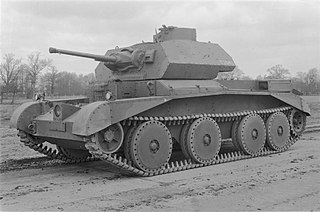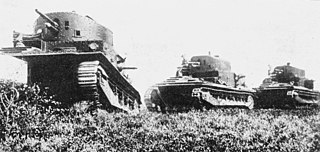
The Infantry Tank Mark II, best known as the Matilda, is a British infantry tank of the Second World War.

The Tank, Infantry, Mk IV (A22) Churchill was a British infantry tank used in the Second World War, best known for its heavy armour, large longitudinal chassis with all-around tracks with multiple bogies, its ability to climb steep slopes, and its use as the basis of many specialist vehicles. It was one of the heaviest Allied tanks of the war.

The Cromwell tank, officially Tank, Cruiser, Mk VIII, Cromwell (A27M), was one of the series of cruiser tanks fielded by Britain in the Second World War. Named after the English Civil War-era military leader Oliver Cromwell, the Cromwell was the first tank put into service by the British to combine high speed from a powerful, reliable engine and reasonable armour. The intended dual-purpose high velocity gun could not be fitted in the turret, so a medium velocity dual purpose gun was fitted instead. Further development of the Cromwell combined with a high velocity gun led to the Comet tank.

The AC1 Sentinel was a cruiser tank designed in Australia in World War II in response to the war in Europe, and to the threat of Japan expanding the war to the Pacific or even a feared Japanese invasion of Australia. It was the first tank to be built with a hull cast as a single piece, and the only tank to be produced in quantity in Australia. The few Sentinels that were built never saw action as Australia's armoured divisions had been equipped by that time with British and American tanks.

Crusader, in full "Tank, Cruiser Mk VI, Crusader", also known by its General Staff number A.15, was one of the primary British cruiser tanks during the early part of the Second World War. Over 5,000 tanks were manufactured and they made important contributions to the British victories during the North African campaign. The Crusader tank would not see active service beyond Africa but the chassis of the tank was modified to create anti-aircraft, fire support, observation, communication, bulldozer and recovery vehicle variants.

The Tank, Cruiser, Mk I (A9) was a British cruiser tank of the interwar period. It was the first cruiser tank: a fast tank designed to bypass the main enemy lines and engage the enemy's lines of communication, as well as enemy tanks. The Cruiser Mk II was a more heavily armoured adaptation of the Mark I, developed at much the same time.

The Tank, Cruiser, Mk II (A10), was a cruiser tank developed alongside the A9 cruiser tank, and was intended to be a heavier, infantry tank version of that type. In practice, it was not deemed suitable for the infantry tank role and was classified as a "heavy cruiser". It served briefly in World War II.

The cruiser tank was a British tank concept of the interwar period for tanks designed as modernised armoured and mechanised cavalry, as distinguished from infantry tanks. Cruiser tanks were developed after medium tank designs of the 1930s failed to satisfy the Royal Armoured Corps. The cruiser tank concept was conceived by Giffard Le Quesne Martel, who preferred many small light tanks to swarm an opponent, instead of a few expensive and unsatisfactory medium tanks. "Light" cruiser tanks carried less armour and were correspondingly faster, whilst "heavy" cruiser tanks had more armour and were slightly slower.

The Cruiser tank Mk V or A13 Mk III Covenanter was a British cruiser tank of the Second World War. The Covenanter was the first cruiser tank design to be given a name. Designed by the London, Midland and Scottish Railway as a better-armoured replacement for the Cruiser Mark IV, it was ordered into production in 1939 before pilot models were built. Problems with the design became apparent only after production was under way.

The Tank, Cruiser, Mk III, also known by its General Staff specification number A13 Mark I, was a British cruiser tank of the Second World War. It was the first British cruiser tank to use the Christie suspension system, which gave higher speeds and better cross-country performance; previous cruiser tank models had used triple wheeled bogie suspension.

The Cruiser Tank Mk IV was a British cruiser tank of the Second World War. It followed directly on from the Tank, Cruiser, Mk III. The first Mk IVs were Mk IIIs with extra armour fitted to the turret. Later Mk IVAs were built with the complete extra armour. The tank was used in France in 1940 and in the early part of the war in North Africa, before being withdrawn from service. A fast vehicle compared to other British tanks of the early part of the war, it was probably the best tank Britain had in 1940. In total, 955 of these tanks were built.

The Tank, Cruiser, Ram was a cruiser tank designed and built by Canada in the Second World War, based on the U.S. M3 Medium tank chassis. Due to standardization on the American Sherman tank for frontline units, it was used exclusively for training purposes and was never used in combat as a gun tank. The chassis was used for several other combat roles however, such as a flamethrower tank, observation post and armoured personnel carrier.

The Light Tank Mark I to Mark V were a series of related designs of light tank produced by Vickers for the British Army during the interwar period.
The Tank, Cruiser, Mk VII Cavalier (A24) was an interim design of British cruiser tank during the Second World War.

The Vickers Medium Mark II was a British tank built by Vickers in the Inter-war period.

The Vickers Medium Mark I was a British tank of the Inter-war period built by Vickers from 1924.
This article lists British armoured fighting vehicle production during the Second World War. The United Kingdom produced 27,528 tanks and self-propelled guns from July 1939 to May 1945, as well as 26,191 armoured cars and 69,071 armoured personnel carriers.

The Medium Mark III was a medium tank developed in the United Kingdom during the Interwar period.

This article on military tanks deals with the history and development of tanks of the British Army from their first use in the First World War, the interwar period, during the Second World War, the Cold War and modern era.





















